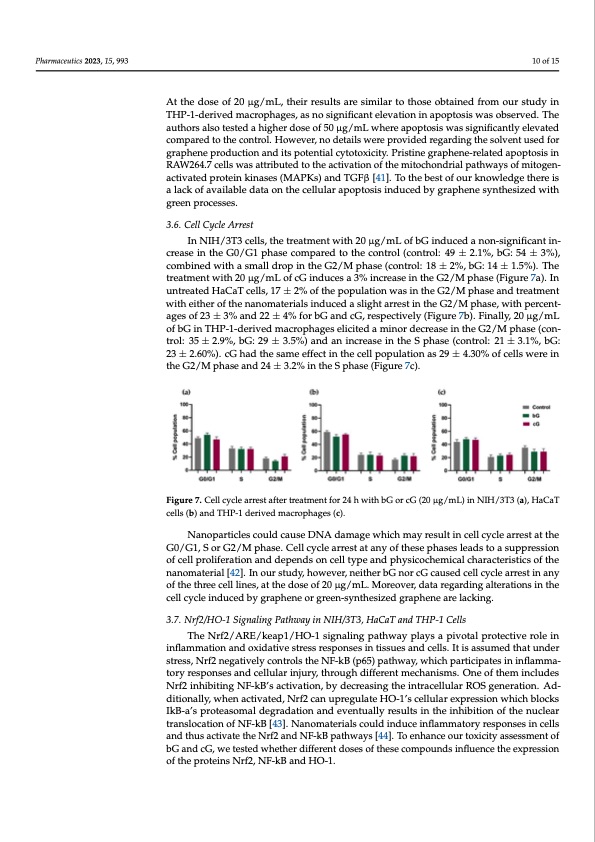PDF Publication Title:
Text from PDF Page: 010
Pharmaceutics 2023, 15, x FOR PEER REVIEW 10 of 16 Pharmaceutics 2023, 15, 993 Figure 6. Depiction of the live, apoptotic, and necrotic cell population (%) in NIH/3T3 (a), HaCaT (b) and THP-1 cells (c) after treatment with 20 μg/mL of either bG or cG, for 24 h. 10 of 15 There is not enough available data related to apoptosis induced by pristine graphene. Li et al. reported that pristine graphene induces apoptosis in RAW264.7 macrophages. At the dose of 20 μg/mL, their results are similar to those obtained from our study in THP-1- At the dose of 20 μg/mL, their results are similar to those obtained from our study in derived macrophages, as no significant elevation in apoptosis was observed. The authors THP-1-derived macrophages, as no significant elevation in apoptosis was observed. The also tested a higher dose of 50 μg/mL where apoptosis was significantly elevated com- authors also tested a higher dose of 50 μg/mL where apoptosis was significantly elevated pared to the control. However, no details were provided regarding the solvent used for compared to the control. However, no details were provided regarding the solvent used for graphene production and its potential cytotoxicity. Pristine graphene-related apoptosis in graphene production and its potential cytotoxicity. Pristine graphene-related apoptosis in RAW264.7 cells was attributed to the activation of the mitochondrial pathways of mito- RAW264.7 cells was attributed to the activation of the mitochondrial pathways of mitogen- gen-activated protein kinases (MAPKs) and TGFβ [41]. To the best of our knowledge there activated protein kinases (MAPKs) and TGFβ [41]. To the best of our knowledge there is is a lack of available data on the cellular apoptosis induced by graphene synthesized with a lack of available data on the cellular apoptosis induced by graphene synthesized with green processes. green processes. 3..6.. Celll Cyclle Arrest IInNIIH/3T3 cells,, the treatment with 20 μμg/mLLooffbGiinducceeddaanon--ssiignififiiccaannttinin-- ccrreaseintheG0/GG11pphhasaesecocmompapraerdedtottohethceoncotrnotlro(clo(nctornotlr:o4l9:±492.1±%2,.b1G%:,5b4G±:35%4)±,co3m%-), cboimnebdinweidthwaisthmalslmdraolpldinrotpheinGt2h/MeGp2h/aMse(pchoanstero(lc:o1n8t±ro2l%:1,8bG±:124%±,1b.G5%:1).4T±he1t.r5e%at)m.Tehnet twreiathtm2e0nμtgw/mithL2o0fμcGg/imndLuocfescGa i3n%duinccerseas3e%inintchreaGs2e/Min tphheaGse2(/FMiguprhea7sea)(.FIingurnetr7ea)t.eIdn uHnatrCeaTtecdelHlsa,C17aT±c2e%llso,f1t7he±p2o%puolfathioenpwopasuilnattiohneGw2a/sMinpthaesGea2n/dMtrpehaatmseeanntdwtirtehaetmitheenrt wofitthheitnhaenroomfathterinaalsnoinmdautceerdiaalssilnigdhutcaerdreasstlinghthtearGre2s/tMinpthaesGe,2w/Mithphearsce,nwtaigthespoefrc2e3n±t- a3g%esaonfd2232±34%faonrdb2G2a±nd4%cGf,orebspGeactnivdeclyG(,Friegsupreect7ibv)e.lFyin(Failglyu,r2e07μb)g./mFiLnaollfyb,G20inμgT/HmPL- o1f-dbeGriivnedTHmPa-c1r-odpehriavgeds meliaccitreodphaamgeinsoerlicdietecrdeasme inotrhedeGc2re/Masepihnasthee(cGo2n/trMol:p3h5a±se2(.c9o%n,- tbroGl:2395±3.25.%9%),anbdG:an29in±cr3ea.5s%e)inatnhdeaSnpihnacsrea(csoenitnrotlh:e21S±p3h.a1s%e,(bcGon: 2tr3o±l:22.610±%)3..1c%G,hbaGd: 2t3he±sa2m.60e%ef)f.ecGt inhathdetchellspamopeuelaffteiocnt ianst2h9e±ce4l.3l 0p%opouflcaetlilosnwaesre29in±th4e.3G0%2/Mofpcheallsewanerde2i4n t±he3.G2%2/iMn tphheaSsephaansde2(F4i±gu3r.e2%7c)i.n the S phase (Figure 7c). Fiigurre7..Celllcycllearresttafftterrttrreeattmeenttfforr2244hwiitthbbGoorrccG((2200μμgg//mL) in NIH/3T3((a)),,HaCaT cceelllss((b))andTHP--1derriivedmacrophages(c).. Nanoparticles could cause DNA damage which may result in cell cycle arrest at the Nanoparticles could cause DNA damage which may result in cell cycle arrest at the G0/G1, S or G2/M phase. Cell cycle arrest at any of these phases leads to a suppression G0/G1, S or G2/M phase. Cell cycle arrest at any of these phases leads to a suppression of of cell proliferation and depends on cell type and physicochemical characteristics of the cell proliferation and depends on cell type and physicochemical characteristics of the na- nanomaterial [42]. In our study, however, neither bG nor cG caused cell cycle arrest in any nomaterial [42]. In our study, however, neither bG nor cG caused cell cycle arrest in any of the three cell lines, at the dose of 20 μg/mL. Moreover, data regarding alterations in the of the three cell lines, at the dose of 20 μg/mL. Moreover, data regarding alterations in the cell cycle induced by graphene or green-synthesized graphene are lacking. cell cycle induced by graphene or green-synthesized graphene are lacking. 3.7. Nrf2/HO-1 Signaling Pathway in NIH/3T3, HaCaT and THP-1 Cells 3.7. Nrf2/HO-1 Signaling Pathway in NIH/3T3, HaCaT and THP-1 Cells The Nrf2/ARE/keap1/HO-1 signaling pathway plays a pivotal protective role in The Nrf2/ARE/keap1/HO-1 signaling pathway plays a pivotal protective role in in- inflammation and oxidative stress responses in tissues and cells. It is assumed that under flammation and oxidative stress responses in tissues and cells. It is assumed that under stress, Nrf2 negatively controls the NF-kB (p65) pathway, which participates in inflamma- stress, Nrf2 negatively controls the NF-kB (p65) pathway, which participates in inflam- tory responses and cellular injury, through different mechanisms. One of them includes matory responses and cellular injury, through different mechanisms. One of them in- Nrf2 inhibiting NF-kB’s activation, by decreasing the intracellular ROS generation. Ad- cludes Nrf2 inhibiting NF-kB’s activation, by decreasing the intracellular ROS generation. ditionally, when activated, Nrf2 can upregulate HO-1’s cellular expression which blocks Additionally, when activated, Nrf2 can upregulate HO-1′s cellular expression which IkB-a’s proteasomal degradation and eventually results in the inhibition of the nuclear translocation of NF-kB [43]. Nanomaterials could induce inflammatory responses in cells and thus activate the Nrf2 and NF-kB pathways [44]. To enhance our toxicity assessment of bG and cG, we tested whether different doses of these compounds influence the expression of the proteins Nrf2, NF-kB and HO-1.PDF Image | Green Exfoliation of Graphene

PDF Search Title:
Green Exfoliation of GrapheneOriginal File Name Searched:
pharmaceutics-15-00993.pdfDIY PDF Search: Google It | Yahoo | Bing
Salgenx Redox Flow Battery Technology: Power up your energy storage game with Salgenx Salt Water Battery. With its advanced technology, the flow battery provides reliable, scalable, and sustainable energy storage for utility-scale projects. Upgrade to a Salgenx flow battery today and take control of your energy future.
CONTACT TEL: 608-238-6001 Email: greg@infinityturbine.com (Standard Web Page)